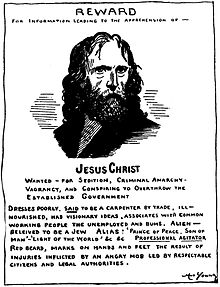Vagrancy


A vagrant or a vagabond is a person, often in poverty, who wanders from place to place without a home or regular employment or income. Other synonyms include "tramp," "hobo," and "drifter". A vagrant could be described as being "a person without a settled home or regular work who wanders from place to place and lives by begging"; vagrancy is the condition of such persons.[1]
Both "vagrant" and "vagabond" ultimately derive from Latin word vagari "wander." The term "vagabond" is derived from Latin vagabundus. In Middle English, "vagabond" originally denoted a criminal.[2]
History

In settled, ordered communities, vagrants have been historically characterised as outsiders, embodiments of otherness, objects of scorn or mistrust, or worthy recipients of help and charity. Some ancient sources show vagrants as passive objects of pity, who deserve generosity and the gift of alms. Others show them as subversives, or outlaws, who make a parasitical living through theft, fear and threat. Some fairy tales of medieval Europe have beggars cast curses on anyone who was insulting or stingy towards them. In Tudor England, some of those who begged door-to-door for "milk, yeast, drink, pottage" were thought to be witches.[3]
Many world religions, both in history and today, have strong vagrant traditions. Jesus is seen in the Bible teaching compassion for beggars, prostitutes, and the disenfranchised himself, telling his followers to give away their possessions and becoming wanderers themselves. These traditions dominated early Christian movements and were encouraged by notable figures such as St. Paul. Many still survive in places like Europe, Africa, and the Near East, as preserved by Gnosticism, Hesychasm, and various esoteric practices. The Catholic church also teaches compassion for people living in vagrancy[4] and many Christian denominations recognize various aspects of ascetic teachings that are found in scripture.
In some East Asian and South Asian countries, the condition of vagrancy has long been historically associated with the religious life, as described in the religious literature of Hindu, Buddhist, Jain and Muslim Sufi traditions. Examples include sadhus, dervishes, Bhikkhus and the sramanic traditions generally.
Vagrancy laws
Germany
In Germany, according to the 1871 Penal Code (§ 361 des Strafgesetzbuches von 1871), vagabondage was among the grounds to confine a person to a labor house.[5][6]
In the Weimar Republic, the law against vagrancy was relaxed, but it became much more stringent in Nazi Germany, where vagrancy, together with begging, prostitution, and "work-shyness" (arbeitsscheu), was classified "asocial behavior" as punishable by confinement to concentration camps.
Russia
Tsardom of Russia
In the Tsardom of Russia, the legal term "vagrancy" (Template:Lang-ru, brodyazhnichestvo) was defined in another way than respective terms (vagabondage, Landstreicherei) in Western Europe. Russian law recognized one as a vagrant if he could not prove his own standing (title), or if he changed his residence without a permission from authorities, rather than punishing loitering or absence of livelihood. Foreigners who had been twice expatriated with prohibition of return to the Russian Empire and were arrested in Russia again were also recognized as vagrants. Punishments were harsh: According to Ulozhenie,[7] a vagrant who could not elaborate on his kinship, standing, or permanent residence, or gave false evidence, was sentenced to 4-year imprisonment and subsequent exile to Siberia or another far-off province.
Soviet Union
In the Criminal Code of the RSFSR (1960), which came into force on 1 January 1961, systematic vagrancy (that which was identified more than once) was punishable by up to two years' imprisonment (section 209).[8]
This continued until 5 December 1991, when Section 209 was repealed and vagrancy ceased to be a criminal offence.[9]
Modern Russia
At present, vagrancy is not a criminal offence in the Russian Federation, but it is an offence for someone over 18 to induce a juvenile (one who has not reached that age) to vagrancy (CC of RF, section 151).
United Kingdom

The first major vagrancy law was passed in 1349 to increase the workforce following the Black Death by making "idleness" (unemployment) an offence. By the 16th century the statutes were mainly used as a means of controlling criminals. In 16th and 17th century England, a vagrant was a person who could work but preferred not to (or could not find employment, so took to the road in order to do so), or one who begged for a living. Vagrancy was illegal, punishable by branding, whipping, conscription into the military, or at times penal transportation to penal colonies. Vagrants were different from impotent poor, who were unable to support themselves because of advanced age or sickness. However, the English laws usually did not distinguish between the impotent poor and the criminals, so both received the same harsh punishments.
In 1530, Henry VIII decreed that "beggars who are old and incapable of working receive a beggar's licence. On the other hand, whipping and imprisonment for sturdy vagabonds. They are to be tied to the cart-tail and whipped until the blood streams from their bodies, then they are to swear on oath to go back to their birthplace or to serve where they have lived the last three years and to 'put themselves to labour'. For the second arrest for vagabondage the whipping is to be repeated and half the ear sliced off; but for the third relapse the offender is to be executed as a hardened criminal and enemy of the common weal."[10]
In 1547, Edward VI ordained that "if anyone refuses to work, he shall be condemned as a slave to the person who has denounced him as an idler. The master has the right to force him to do any work, no matter how disgusting, with whip and chains. If the slave is absent for a fortnight, he is condemned to slavery for life and is to be branded on forehead or back with the letter S; if he runs away three times, he is to be executed as a felon...If it happens that a vagabond has been idling about for three days, he is to be taken to his birthplace, branded with a red hot iron with the letter V on his breast, and set to work, in chains, on the roads or at some other labour...Every master may put an iron ring round the neck, arms or legs of his slave, by which to know him more easily."[11]
In 1572, Elizabeth I decreed "unlicensed beggars above 14 years of age are to be severely flogged and branded on the left ear unless someone will take them into service for two years; in case of a repetition of the offence, if they are over 18, they are to be executed, unless someone will take them into service for two years; but for the third offence they are to be executed without mercy as felons."[12]
James I ordained that "anyone wandering about and begging is declared a rogue and a vagabond. Justices of the peace are authorized to have them publicly whipped and to imprison them for six months for the first offence, and two years for the second. While in prison they are to be whipped as much and as often as the justices of the peace think fit...incorrigible and dangerous rogues are to be branded with an R on the left shoulder and set to hard labour, and if they are caught begging again, they are to be executed without mercy." These laws were legally binding until the beginning of the eighteenth century; they were repealed by 12 Anne, c. 23[13]
In 1824, earlier vagrancy laws were consolidated in the Vagrancy Act 1824 (UK) whose main aim was removing undesirables from public view. The act assumed that homelessness was due to idleness and thus deliberate, and made it a criminal offence to engage in behaviours associated with extreme poverty. The Poor Law was the system for the provision of social security in operation in England and Wales from the 16th century until the establishment of the Welfare State in the 20th century.
United States

In colonial America, anyone who wandered into a town and did not find work was told to leave town or face prosecution. [citation needed]
After the American Civil War, the Southern United States passed Black Codes, laws that tried to control freed slaves. Vagrancy laws were included in these codes. Homeless unemployed Black Americans were arrested and fined as vagrants. Usually, the person could not afford the fine, and so was sent to work in convict leasing camps. In these camps is where they would remain, "paying their debt", and inevitably be re-enlisted back into slavery by white slave holders.[citation needed]
Since at least as early as the 1930s, a vagrancy law in America typically has rendered "no visible means of support" a misdemeanor, yet it has commonly been used as a pretext to take one into custody for such things as loitering, prostitution, drunkenness, or criminal association. [citation needed]
In the 1960s, laws proven unacceptably broad and vague were found to violate the due process clause of the Fourteenth Amendment to the United States Constitution. [citation needed] Such laws could no longer be used to obstruct the "freedom of speech" of a political demonstrator or an unpopular group. Ambiguous vagrancy laws became more narrowly and clearly defined.[citation needed]
In Papachristou v. Jacksonville, 405 U.S. 156 (1972), the Supreme Court of the United States ruled that a Florida vagrancy law was unconstitutional because it was too vague to be understood.[citation needed]
Nevertheless, new local laws in the U.S. have been passed to criminalize aggressive panhandling.[14][15]
In the U.S., some local officials encourage vagrants to move away instead of arresting them. The word vagrant is often (falsely) conflated with the term homeless person. Prosecutions for vagrancy are rare, being replaced by prosecutions for specific offenses such as loitering.[citation needed]
See also
- Anti-homelessness legislation
- Hobo
- Homelessness
- Knight-errant, a wandering knight
- Musha shugyō, a samurai's personal quest
- Ronin, a wandering, masterless samurai
- Simple living
- Squatting
- Status crime
- Vagrancy Act may refer to:
- Vagrancy Act 1824, Act of the Parliament of the United Kingdom
- Vagrancy Act 1838, Act of the Parliament of the United Kingdom
- Parasitism (social offense)
References
- ^ Definitions from Oxford Dictionaries online
- ^ Definition of vagabond from Oxford Dictionaries Online
- ^ The Discovery of Witchcraft (London, 1584) by Reginald Scot[page needed]
- ^ http://www.vatican.va/holy_father/francesco/apost_exhortations/documents/papa-francesco_esortazione-ap_20131124_evangelii-gaudium_en.html
- ^ The unsettled, "asocials" University of Minnesota
- ^ Ayaß, Wolfgang (1992). Das Arbeitshaus Breitenau. Bettler, Landstreicher, Prostituierte, Zuhälter und Fürsorgeempfänger in der Korrektions- und Landarmenanstalt Breitenau (1874–1949). Kassel. ISBN 3881226702.
{{cite book}}: CS1 maint: location missing publisher (link) - ^ Уложение о наказаниях уголовных и исправительных, ст. 950—954
- ^ Закон РСФСР от 27.10.1960 «Об утверждении Уголовного кодекса РСФСР" (вместе с «Уголовным кодексом РСФСР»)» // Свод законов РСФСР. — т. 8, — с. 497, 1988 // Ведомости ВС РСФСР. — 1960. — № 40. — ст. 591
- ^ Закон «О внесении изменений и дополнений в Уголовный кодекс РСФСР, Уголовно-процессуальный кодекс РСФСР и кодекс РСФСР об административных правонарушениях» jn 5.12.1991 № 1982-I // Ведомости Съезда НД РФ и ВС РФ, N 52, 26.12.91, ст. 1867
- ^ Marx, Karl (1976). Capital Volume I. Ernest Mandel, Ben Fowkes. England: Pelican Books. p. 896. ISBN 978-0-14-044568-8.
- ^ An Act for the Punishing of Vagabonds, 1 Edward VI, c. 3
- ^ An Act for the Punishment of Vagabonds, 14 Elizabeth I, c. 5
- ^ Marx, Karl (1976). Capital Volume I. England: Pelican Books. pp. 898–899. ISBN 978-0-14-044568-8.
- ^ Legal Opinion 2008-1 (On Aggressive Panhandling) Nashville, February 20, 2008
- ^ Aggressive Panhandling & Solicitation —It’s a Crime and You Can Help! City of Minneapolis
Bibliography
- Beier, A.L., and Ocobock, Paul (editors), Cast out: vagrancy and homelessness in global and historical perspective, Center for International studies, Ohio University, 2008.
